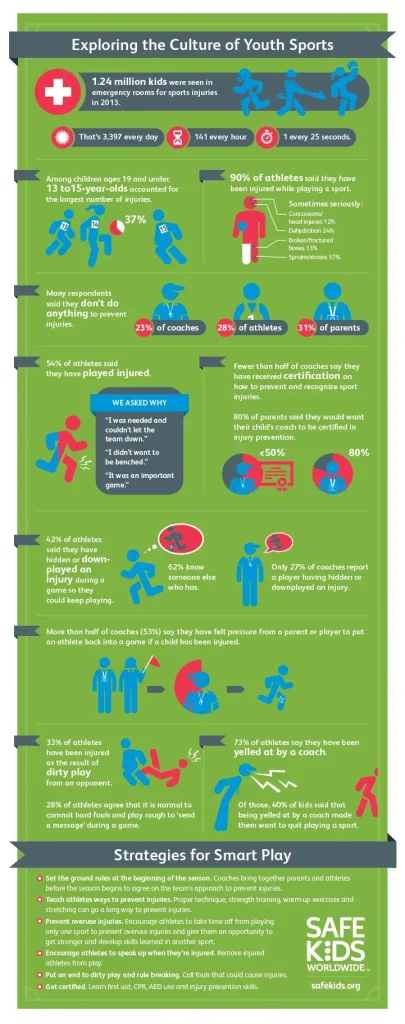Youth sports safety is a top priority for everyone involved in a young athlete’s journey. As kids lace up their shoes and take the field, court, or track, the goal is to enjoy the game while staying healthy and protected, learning teamwork, discipline, and good sportsmanship along the way. This introductory paragraph outlines practical, evidence-based best practices that empower kids, parents, and coaches to create a safer, more enjoyable sporting experience, encourage open dialogue about risk, and build confidence in everyday decisions. By focusing on injury prevention, proper equipment, environment, and safe coaching, families and teams can reduce risks and keep participation positive and sustainable, while also promoting regular monitoring of fatigue signs, hydration, sleep quality, and gradual progression. These guidelines emphasize preparation, supervision, and a culture of care that supports skill development, resilience, and long-term participation in sport for youth while fostering a climate where safety is understood as everyone’s responsibility.
Within the realm of youth athletics, safety begins with proactive planning, clear roles, and age-appropriate expectations. Caregivers and coaches can support well-being by emphasizing proper warm-ups, rest days, and recovery strategies that reduce fatigue and overuse. Protective gear should be chosen to fit each child comfortably and checked regularly, while facilities are designed to minimize hazards and encourage safe movement. Engaging families in safety education reinforces consistent behaviors across practice, travel, and competition, helping every young athlete stay focused on healthy development. By framing safety as a collaborative, ongoing process, communities can sustain participation and enjoyment while lowering the risk of injuries.
Youth sports safety: Practical tips for injury prevention, equipment, and safe facilities
To advance Youth sports safety, start with practical tips for injury prevention in youth sports. Implement dynamic warm-ups, sport-specific neuromuscular training, adequate hydration, and equipment that fits properly, including helmets, pads, mouthguards, and properly fitted footwear. Regular checks of gear before practices and games help catch wear or damage that could compromise safety and reinforce the idea that injury prevention in youth sports is a shared responsibility. These steps create a foundation where young athletes can focus on skill-building while staying protected.
Safe facilities are as crucial as safe equipment. Safety guidelines for youth sports require regular field inspections, hazard removal, proper lighting, and secure spectator areas. Clear reporting channels empower families and coaches to address issues promptly, reducing risk on the field, court, or track. By integrating these standards into daily routines, programs minimize injuries and keep participation positive, sustainable, and aligned with proven youth sports safety tips.
Coaching safety practices and parent involvement in youth sports safety: Building a culture of care
Coaching safety practices form the core of a protective sports environment. Coaches should model safe behavior, clearly explain correct techniques, and give corrective feedback that prioritizes skill development over competition at all costs. They must monitor signs of fatigue, adjust drills accordingly, and maintain a favorable coach-to-player ratio to ensure every athlete receives attention. Emphasizing concussion awareness—recognizing symptoms, removing a suspected case from play, and following return-to-play protocols—creates a safer, more trusting atmosphere for young athletes.
Parent involvement in youth sports safety is essential for a culture of care. Open communication with coaches about medical histories, injuries, and recovery plans promotes safer participation. Parents should ensure protective equipment is fitted and maintained and that uniforms suit the child’s size and development. Participation in safety education sessions helps families stay informed about safety guidelines for youth sports, proper hydration, and balanced scheduling to prevent overcommitment and fatigue, ultimately reinforcing youth sports safety tips at home and in the community.
Frequently Asked Questions
What are the essential safety guidelines for youth sports to minimize injuries?
Key safety guidelines for youth sports include safe equipment and facilities, injury prevention, and clear practice and game protocols. Ensure gear fits properly and protective equipment is appropriate for the sport, with regular pre-practice checks. Promote injury prevention in youth sports through dynamic warm-ups, hydration, proper nutrition, adequate sleep, and neuromuscular training to improve landing mechanics and reduce injuries. Implement safety guidelines for practices and games with progressive drills, adequate rest, rule enforcement, and concussion awareness. When coaches and parents collaborate through coaching safety practices and parent involvement in youth sports safety, participation stays safer and more enjoyable.
How can coaching safety practices and parent involvement in youth sports safety enhance injury prevention in youth sports?
Coaching safety practices—modeling safe technique, providing clear instructions, monitoring fatigue and pain, and enforcing return-to-play protocols—reduce injury risk. This is complemented by active parent involvement in youth sports safety—ensuring proper equipment fit, attending safety education sessions, maintaining gear, and supporting balanced schedules. Together, these efforts create a safety-first culture that enhances injury prevention in youth sports and supports long-term participation.
| Area | Key Points | Practical Actions |
|---|---|---|
| Introduction | Youth sports safety focuses on enjoyment, health, and protection; injury prevention, equipment, environment, and safety culture. | Adopt best practices; involve kids, parents, and coaches; prioritize safety-focused participation. |
| Safe Equipment and Facilities | High-quality equipment and well-maintained facilities; protective gear should fit properly and reduce injury risk. | Check equipment before each practice/game; report facility hazards; ensure proper lighting, field markings, and secure spectator areas. |
| Injury Prevention for Kids | Conditioning builds strength, flexibility, endurance; warm-ups with dynamic stretching; hydration, nutrition, sleep, and recovery are essential. | Implement comprehensive conditioning; ensure regular hydration; monitor fatigue; use age-appropriate progression; teach safe techniques. |
| Safety Guidelines for Practices and Games | Progressive drills; sufficient rest; balanced practice plans; rule enforcement and fair play; parents understand rules. | Plan age-appropriate practices; schedule rest days; enforce rules; communicate safety expectations to families. |
| Coaching Safety Practices | Coaches model safe behavior; emphasize proper technique; monitor fatigue; maintain appropriate coach-to-player ratios; concussion awareness. | Provide technique explanations; monitor signs of fatigue/pain; train for concussion recognition; follow return-to-play protocols. |
| Parental Involvement in Youth Sports Safety | Open communication about medical histories, injuries, and recovery; ensure equipment fit; participate in safety education. | Attend safety sessions; verify equipment size and maintenance; support balanced schedules and safe habits at home. |
| Environmental and Weather Considerations | Weather affects safety; adjust practice length, hydration, and protective measures; review field conditions and emergency access. | Avoid peak heat; provide shade/cooling; extend warm-ups in cold weather; use appropriate gear for rain/snow. |
| Emergency Preparedness and Return-to-Play Protocols | First aid kit, medical contact, and clear communication plan; staff trained in basic first aid and CPR; access to medical facilities. | Train staff; maintain first aid kit; ensure access to facilities; follow medical clearance and structured progression. |
| Education, Culture, and Continuous Improvement | Ongoing education for kids, parents, and coaches; data collection on injuries and near-misses; feedback loops for safety improvements. | Regular workshops; track injuries/compliance; implement data-driven improvements. |
Summary
Conclusion: Youth sports safety emphasizes collaborative, ongoing efforts to keep young athletes healthy and engaged in sport. Through safe equipment, proactive injury prevention, clear guidelines for practices and games, thoughtful coaching, engaged parental involvement, and a culture of continuous improvement, youth sports safety helps communities create safer, more enjoyable athletic experiences. By prioritizing education, preparedness, and responsible participation, families and teams can support long-term well-being and lasting enjoyment of sport for kids.



